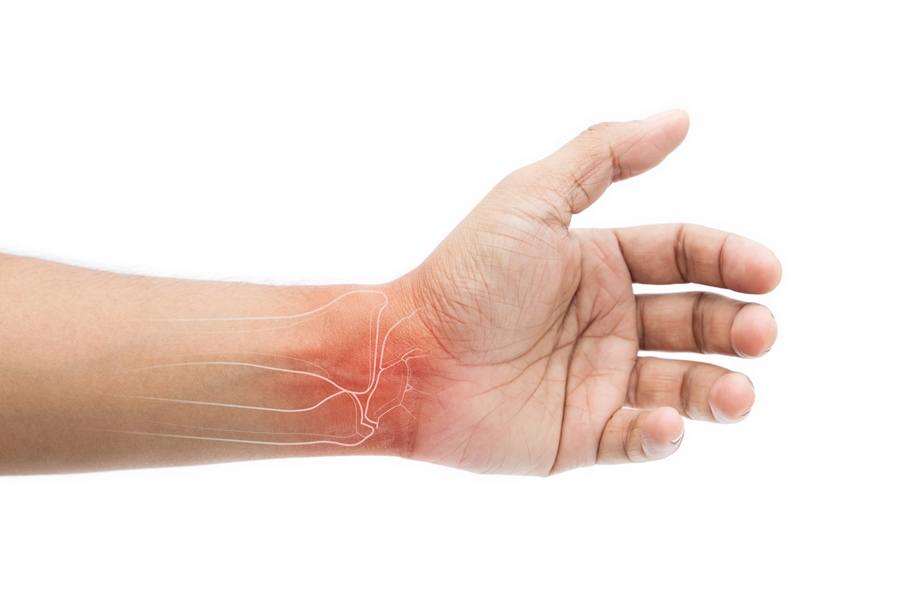A condition affecting the hand and wrist, carpal tunnel affects a lot of people, having a serious detrimental effect on people’s well-being and everyday lives.
This is why understanding the stages of carpal tunnel syndrome is so important, as early treatment can be key in helping you maintain good hand health.
In this post, we look at the three main stages of carpal tunnel syndrome: early, moderate, and advanced, and also some of the carpal tunnel syndrome treatment options that are available.
What is carpal tunnel?
Let’s get started with a definition of what carpal tunnel syndrome (CTS) is, as well as signs to look out for.
CTS is an uncomfortable and painful condition affecting the nerves in the hand and wrist.
CTS occurs when the nerve (the median nerve) from your forearm to the palm of your hand becomes compressed at the wrist, i.e., when the tissue around the wrist and tendons swell.
It is the median nerve that controls the sensations we feel in our thumb and fingers (except the little finger), as well as the nerve that supports hand movement by sending impulses to the muscles in the hand.
The median nerve is protected, along with tendons, in the carpal tunnel – a narrow passageway consisting of ligaments, soft tissues, and bones.
This means that when this passageway becomes narrow, or you experience swollen tendons, nerve compression will occur, resulting in the development of carpal tunnel syndrome.
CTS can significantly impact a person’s ability to perform daily tasks, making early diagnosis crucial.
Stages of carpal tunnel
Early stages of carpal tunnel
The early stages of carpal tunnel syndrome can be sporadic and incredibly subtle in the beginning, making them easy to overlook.
Feelings and aching sensations can come and go at any time or after certain activities, which, when you shake your hand, will disappear.
Some of the signs to look out for include:
- Numbness
- Tingling sensation in the fingers and thumb
These signs are only temporary at this stage, which, with rest and stretches, will ease.
Moderate stages of carpal tunnel
At this stage, numbness and tingling in the hand will become more persistent, with pain extending to the wrist. You may also experience an aching sensation in the forearm, reduced hand strength, muscles might feel weaker, and you may experience slightly more nerve compression and more pain during the night.
At this stage, you may notice that your fine motor skills are affected, and everyday tasks such as typing and gripping objects become more difficult.
It can also affect your driving and playing a musical instrument and be linked to uncoordinated hand movements.
Pain relief at this stage can be achieved through over-the-counter medications and simple exercises, such as flexing the wrist, squeezing a rubber ball, and bending your fingers.
Severe carpal tunnel syndrome
Moderate to severe carpal tunnel syndrome is when all symptoms are constant, with pain being considered as chronic. You will have a decrease in grip strength; you may be unable to distinguish between hot and cold, and without appropriate treatment, muscle wastage starting at the base of the thumb can occur, as well as deterioration of muscle tissue.
Without preventative carpal tunnel treatment, you can risk permanent nerve damage.
Splints may be recommended, along with stronger pain relief injections, and in severe cases surgery.
Causes of carpal tunnel syndrome
There is no one specific reason why you may experience carpal tunnel syndrome or why it might start/flare up.
Some of the most common causes include:
- Repetitive hand movement/strain
- Poor wrist position
- Age
- Obesity
- Pregnancy – as joints become swollen
- It can be heredity
- Rheumatoid arthritis
- Diabetes
- If you have experienced a wrist injury such as a sprain, fracture, etc
- Repeatedly using vibrating machinery.
Carpal tunnel syndrome treatment
There are a range of non-surgical and surgical options available to effectively treat carpal tunnel syndrome.
Non-surgical:
- Non-steroid anti-inflammatory drugs – can help to reduce swelling and inflammation, hence relieving pain.
- Splints – splints can help to protect the wrist and allow it to rest as it remains in a neutral position.
- Corti steroidal injections
- Physiotherapy
- Ergonomic adjustments when working
Surgery:
If surgery is required, the more traditional method is to open the carpel tunnel to release the pressure. In this instance, an incision will be made in the palm of the hand, and a cut at the transverse carpal ligament will be carried out to relieve the pressure.
Surgery does, of course, come with risks; it is a longer recovery, and there is the chance of infection and scarring.
Treatment for carpal tunnel syndrome
If you’re experiencing any of the signs of carpal tunnel syndrome, please speak with a professional as soon as possible.
At Ladan Hajipour, we will carry out a physical examination, take a detailed medical history, as well as look to carry out more in-depth tests if required.
Our advanced diagnostic testing allows us to confirm what stage you are at and the best course of treatment for you.
To book your appointment, contact us today and see how we can help.



